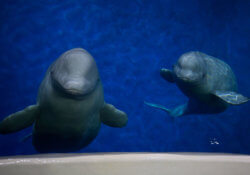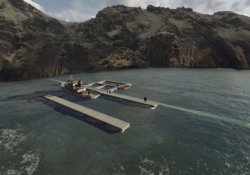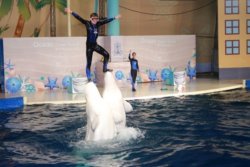By this time next year, the Sea Life Trust expects to have opened the world’s first seaside sanctuary for formerly captive beluga whales. It’s being built on the island of Heimaey, of Vestmannaeyjar (the Westman Islands) off the coast of Iceland, and its first two residents will be two belugas from an entertainment park in China.
The park, Changfeng Ocean World, was purchased by Merlin Entertainments in 2012. And while Merlin’s partner, Sea Life, operates aquariums around the world, the two companies have a longstanding policy of not displaying whales and dolphins at any of their facilities.
Changfeng had three belugas on display at the park, so Merlin and Sea Life immediately began making plans to move them to a sanctuary where they could have a more natural life. One of the belugas has since passed away, but the other two, Little Grey and Little White, are already preparing for what will be a long flight next year, across two oceans from Shanghai to their new Icelandic home.

Little Grey and Little White are preparing for a long flight from Shanghai to a sanctuary in Iceland.
The cost of construction of the sanctuary, along with the transport of Little Grey and Little White, is being covered by a donation from Merlin to marine focused charity the Sea Life Trust. And the ensuing care of the animals and operation of the sanctuary will be the responsibility of the charity, which is partnering with Whale & Dolphin Conservation (WDC), a U.K.-based charity that supports and leads whale and dolphin conservation field projects and research around the world.
Working together, Sea Life Trust and WDC say they looked at sites in Russia, North America, Norway and Scotland before deciding on Iceland. They settled on Klettsvik Bay, a large natural sea inlet that was used 20 years ago for the rehab and release of the orca Keiko, the real-life star of the 1993 feature film Free Willy. Charles Vinick, who managed the Keiko Project and is Executive Director of the Whale Sanctuary Project, remembers it well.
“It’s a beautiful bay, tucked just inside the entrance to the Heimay harbor” he recalls. “But it can get rough weather; so, I hope everyone involved in creating a sanctuary there is well prepared for that!”
The large bay area, which measures nearly eight acres and has a depth of up to 33 feet, provides plenty of space for the belugas to swim, explore and dive.

Artist’s impression of the future Sea Life Trust sanctuary.
Sea Life Trust has already started building the necessary care facilities for the whales, and is also planning a visitor and education center, along with a puffin hospital. James Burleigh, Board member of the Sea Life Trust, explains that three-to-four thousand “pufflings” hatch on the local islands every year.
“When they start learning to fly, they get disoriented and land in the nearby town (also called Heimaey). The kids rescue them, and they get weighed, named and photographed, and then the kids go to the beach with their parents and release them. So, we’re going to have a sanctuary for some of those puffins that might need a bit of help, too.”
Burleigh, who is also Divisional Director for Merlin Conservation, Welfare and Engagement, says that the policy of Merlin and Sea Life not to have whales and dolphins at any of their facilities goes back nearly 30 years. He recalls a time, back in 1990, when Sea Life took over a dolphinarium in the south of England.
“We took two dolphins, Missy and Silver, to the Turks and Caicos Islands and released them there. We know a lot more about rehab today than we did back then, but that’s where the seed was sown. That’s when our principles were founded. We don’t judge what other people do, but do talk positively about our stance.”

Beluga whales at Changfeng Ocean World under its former management
Sea Life still operates aquariums all over the world – 48 centers in 17 countries – but none with cetaceans. “We want people to fall in love with the ocean,” Burleigh says. “And we’ll do it through our aquaria. But we won’t do it with whales and dolphins.”
While there been a significant change in public opinion in Europe regarding keeping whales in captivity, Burleigh agrees that that’s not the case yet in China and many other parts of Asia.
“This became a bigger challenge for us in Changfeng because cetaceans are a large part of the marine entertainment industry in China. The belugas had been there for eight years before we even arrived. And it’s not that they don’t love the animals there. They love these animals. They’re amazed by them. But they just have a different approach to it.”
The two companies have a longstanding policy of not displaying whales and dolphins at any of their facilities.
Burleigh doesn’t want to comment on the practices of other companies’ marine entertainment parks. “We can’t start to judge that,” he says. But he agrees that in the U.S. the documentary Blackfish “was a key that unlocked the door” in public opinion.
Two years ago, in the United States, the National Aquarium announced plans to create a seaside sanctuary for all their dolphins, most likely in Florida. In an op-ed piece in the Baltimore Sun, National Aquarium CEO John Racanelli wrote: “Through feedback painstakingly gathered over 10 years, we have learned that the American public is increasingly uneasy with the notion of keeping dolphins and whales in captivity.”
Other display facilities in the United States have yet to follow suit, but Burleigh observes significant changes already taking place.
“I still think that when you look at what people go and pay money for and what they enjoy as families in America, now, it’s very different from how they did it 20 years ago,” he says. “Your experiences are totally different, and the technologies are different. You’ve got virtual reality, augmented reality, all sorts of stuff. People don’t need to be in a pool swimming with dolphins. They can have that essential experience in different ways.”
He believes the same will unfold in China. “The world will change, and people will change, and we’ve had a lot of support there. And people understand where the direction is. And for us, we just have to set an example and do it the way we do it.”
All of which will be just fine with Little White and Little Grey.
4 Comments
Progress. It’s step by step but a step in the right directions. So happy to read this update and yay for Little White and Little Grey.
I am very glad to see this making progress. It’s time to set them free and very much hope many countries follow this plan. You know Bob Barker is pleased in hearing this good news. He and myself are good friends and I support all his work. Captivity is not the answer. I will continue to follow your efforts.
This needs to happen to ALL Cetaceans around the world. Captivity is NO LONGER wanted and needed. :)
This is very positive to read. Grateful that a sanctuary is being built for beluga’s.